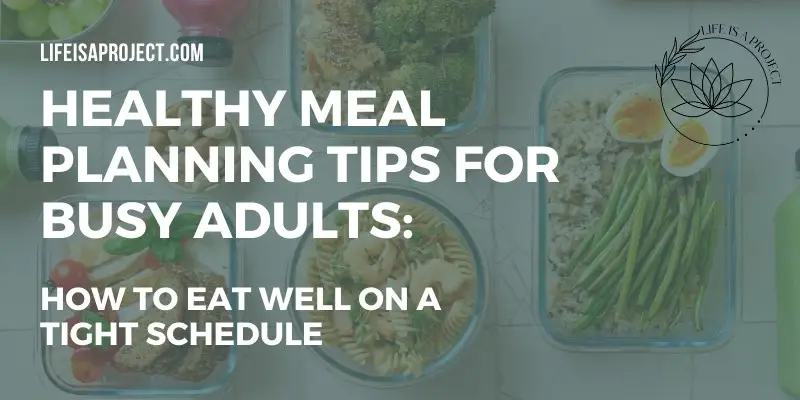Hello, friends! Let’s be real—between hectic work schedules, family commitments, and all the daily chaos, finding time to plan and prepare healthy meals can feel like an impossible task. But eating well doesn’t have to be complicated or time-consuming. With the right approach, you can fuel your body with nutritious food that fits seamlessly into your busy life. Let’s dive into some practical meal planning tips that can help you eat well without the stress, no matter how packed your schedule is.
The Reality: The Struggle to Eat Healthy on a Busy Schedule
We’ve all been there: grabbing takeout on the way home because it’s faster than cooking, skipping meals because there’s no time, or defaulting to less-than-healthy snacks because they’re convenient. It’s easy to fall into these habits when time is short and energy is low. But consistently eating poorly can take a toll on your health, energy levels, and overall well-being.
The good news is, healthy eating doesn’t have to be all or nothing. With some simple meal planning strategies, you can enjoy nutritious meals that support your lifestyle, without spending hours in the kitchen.
Why Meal Planning Matters
Meal planning is like having a roadmap for your nutrition. It helps you save time, reduce stress, and make healthier choices throughout the week. When you know what you’re going to eat and have the ingredients on hand, you’re less likely to resort to unhealthy options. Plus, planning your meals can help you save money, reduce food waste, and ensure you’re getting a balanced diet.
Getting Started: Practical Meal Planning Tips for Busy People
Ready to take control of your meals? Here’s how to start planning and prepping healthy meals that work with your schedule:
1. Start with a Weekly Plan
Begin by setting aside a few minutes each week to plan your meals. You don’t need to plan every single meal—start with dinners or whichever meal tends to be the most challenging. Choose simple recipes that you enjoy and that align with your dietary needs. For inspiration, check out websites like EatingWell or Healthy Eating Plate, which offer balanced meal ideas and easy recipes.
Here’s a simple approach to meal planning:
- Plan for Variety: Choose a mix of proteins, vegetables, and whole grains to keep your meals balanced and interesting.
- Consider Your Schedule: Plan quick meals for busy nights and save more involved recipes for when you have extra time.
- Keep It Realistic: Don’t overcommit. If you know you’ll eat out once or twice, factor that into your plan.
2. Make a Detailed Shopping List
Once you have your meal plan, create a detailed shopping list. Group items by category (produce, proteins, pantry staples) to make your shopping trip efficient. This helps you avoid impulse buys and ensures you have everything you need for the week.
Pro Tip: Save your lists digitally using apps like AnyList or Google Keep, so you can easily update and reuse them.
3. Prep Ingredients Ahead of Time
Meal prep doesn’t mean cooking everything in advance. Even prepping a few key ingredients can make your week much smoother. Here’s how to streamline your prep:
- Wash and chop veggies: Store them in airtight containers so they’re ready to cook or snack on.
- Cook grains and proteins: Prepare basics like quinoa, brown rice, chicken, or tofu that you can mix and match throughout the week.
- Batch-cook or double up: Make double portions of recipes like soups, stews, or casseroles, and freeze half for later.
Spending an hour or two on meal prep can save you a lot of time during the week and make it much easier to throw together healthy meals.
4. Opt for Simple, Nutritious Recipes
When you’re busy, the last thing you need is a complicated recipe with a long list of ingredients. Focus on simple, nutritious meals that are easy to prepare. Here are some go-to options:
- Stir-fries: Quick to cook and easy to customize with whatever veggies and proteins you have on hand.
- Sheet pan meals: Throw everything on a baking sheet—protein, veggies, spices—and roast for an easy, one-pan dinner.
- Salad bowls: Start with greens, add a protein (like chicken or beans), grains (like quinoa), and your favorite toppings. Keep dressings simple, like olive oil and lemon.
Websites like Allrecipes offer thousands of simple and quick meal ideas that can fit into any busy lifestyle.
5. Incorporate Convenience Items Wisely
There’s no shame in using convenience items to save time—as long as you choose wisely. Pre-cut vegetables, canned beans, frozen fruits and veggies, and pre-cooked grains are all great options. Just watch out for added sugars, sodium, or preservatives. Using these shortcuts can help you put together healthy meals faster, without sacrificing nutrition.
6. Have Go-To Snacks Ready
Snacking can be a pitfall when you’re busy, but it doesn’t have to be. Keep healthy snacks on hand so you’re not tempted by less nutritious options. Think:
- Nuts and seeds: Great for a quick, energy-boosting snack.
- Fresh fruit: Pre-washed and easy to grab.
- Hummus and veggie sticks: A satisfying, nutritious option.
- Greek yogurt: High in protein and easy to pair with fruit or nuts.
Keep your snacks visible and within reach, so it’s easy to make a healthy choice when hunger strikes.
Meal Planning on a Budget
Eating healthy doesn’t have to break the bank. Here are some tips to keep your grocery bill in check:
- Buy in bulk: Purchase items like grains, beans, and nuts in bulk to save money.
- Seasonal and frozen produce: Seasonal produce is often cheaper and fresher, while frozen fruits and vegetables are a great budget-friendly option with a long shelf life.
- Shop sales and use coupons: Plan your meals around what’s on sale and look for coupons to cut costs.
For more budget-friendly meal planning tips, check out USDA’s MyPlate website, which offers resources on healthy eating on a budget.
Overcoming Common Meal Planning Challenges
Even with the best intentions, meal planning can have its hurdles. Here’s how to tackle some common challenges:
- “I don’t have time to meal prep.” Start small. Prep just one or two items to ease the burden during the week, like chopping vegetables or cooking a grain.
- “I get bored of eating the same thing.” Keep things interesting by varying your spices, sauces, and cooking methods. Rotate new recipes into your routine to avoid monotony.
- “I don’t like cooking.” Opt for no-cook meals like salads or sandwiches, or focus on recipes with minimal cooking time. Use meal delivery services occasionally to take a break without compromising nutrition.
Conclusion: Meal Planning for Success
Healthy meal planning doesn’t have to be stressful or time-consuming. With a bit of strategy, you can make eating well a seamless part of your busy life. By planning ahead, prepping smart, and keeping things simple, you’ll not only save time and reduce stress but also nourish your body in a way that supports your hectic schedule.
Remember, it’s not about perfection. Some weeks will go smoothly, and others might be more of a challenge. The goal is to build habits that make healthy eating easier over time. So grab your planner, set aside a little time, and start making meal planning work for you. Here’s to eating well, feeling great, and making healthy living a priority—no matter how busy life gets!



